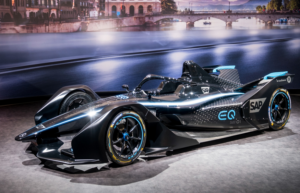While motorsport is facing many restrictions due to policies implemented in all countries on the preservation of the environment, this world is in the midst of a dilemma. The solution of electric to replace the internal combustion engine seems to be a decision towards which some of the motorsport players seem to be turning. Certainly, the debate is indeed present to know what will be the best solution to reduce the impact on the environment. Keep the heat engine with biofuels or use electric? It is more than certain that the electric does not delight the majority of the faithful devotees of these sports, in particular on the aspect of the noise of a heat engine, which is an integral part of this environment. Electric therefore affects, positively for some and negatively for others, the spectacle of a car race. But little by little, electric motorsport is gaining more and more space, even if thermal energy remains the one that is unanimous in the hearts of fans.
The electric motor, older than the heat engine
Contrary to what everyone might think, the electric car is not that recent. The vast majority, once questioned, think that it appeared in the early or mid-2000s. But to think that the first prototype of an electric car appeared before the car equipped with a heat engine , never… And yet it is!
You have to go back to the year 1834 to see the release of the first invention of an electric motor on an automobile. At the same time, the first model of combustion engine, more complex to make, only appeared in 1861.
Electric car model from the mid-1800s – Source: BEQ Technology
Initially, the batteries of electric vehicles were for single use and it was therefore impossible to market these machines. It was thanks to the work of Camille Faure and the invention in 1850 of the rechargeable lead-acid battery by Gaston Planté that manufacturers of electric cars were able to offer their vehicles for consumption for the first time in 1852.
The most powerful model of the time was designed by Camille Jenatzy at the end of the 1890s. Called the “Never-Contente” , this electric car broke a car speed record in 1899 by reaching 105 km/h.
Efficient, rechargeable at a cost lower than the price of fuel, no unbreathable smoke emissions for passers-by, easy to use, electric car models enjoyed great success at the very beginning of the 20th century. Even more on the other side of the Atlantic where the American automobile market is made up of 38% electric vehicles .
But this success was only short-lived because, to counter the rise of electric power and stand out from other competitors in the internal combustion engine market, the Ford company released its Ford T in 1908, which destroyed all its competitors. Assembly line work, less expensive manufacturing materials, incorporation of Charles Kettering’s electric starter model, everything is optimized to offer consumers a car at a reduced price but just as comfortable.
The Ford T is therefore a great success and thanks to this model, many more people can afford to buy a car. At the same time, it is quite naturally that the electric market collapses and falls into oblivion because it is not able to offer a car with such good autonomy and at a price much lower than what is sold. .
Very discreet and out of the spotlight, the electric car came back into fashion during the first oil shock of 1973, which caused fuel prices to explode . It is therefore becoming a solution on which automotive engineers are increasingly looking to find an alternative to the internal combustion engine.
As early as 1974, new electric prototypes appeared on the market, such as the CitiCar, for example, released in the United States. This car had a range of 64km with a maximum speed of 48km/h, so much less efficient than thermal cars. Between this notable lack of performance compared to thermal cars and the price of fuel which finally decreases rapidly, the electric car must still take its troubles patiently to find a place in a market monopolized by thermal energy.
The real entry of the electric car into the automotive market took place in the early 2010s (Thank you Mr. Musk!), in particular thanks to the American brand that has become international: Tesla. Seeing the success of the brand of the American businessman in net growth, the manufacturers, especially in Europe (America remaining on the heat engine when Asia opts for a hybrid engine initially on commercial strategies), begin to develop they are also models of electric cars. This is how we saw the birth of the Renault Zoé, the e-208 and many other models.
This growing craze for electrics in the passenger car has therefore quite naturally begun to give many ideas to the manufacturers of prototypes in motor sports. An idea had become clear: the influence of a brand or a technology in the automobile must pass through strong media coverage. What could be better for media coverage than sport? Interested manufacturers therefore turn to the first opportunity that presents itself to be able to enter the world of motorsport and thus increase media coverage around their brand.



